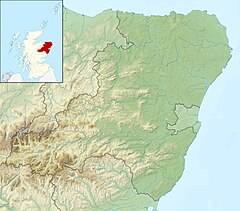| Deeside Gaelic | |
|---|---|
| Aberdeenshire Gaelic | |
| Scottish Gaelic: Gàidhlig Shrath Deathain | |
| Region | Aberdeenshire |
| Extinct | 18 March 1984 with the death of Jean Bain |
Indo-European
| |
Early forms | |
| Language codes | |
| ISO 639-1 |
gd |
| ISO 639-2 |
gla |
| ISO 639-3 |
gla |
| Glottolog |
scot1245 |
Deeside Gaelic is an extinct dialect of Scottish Gaelic spoken in Aberdeenshire until 1984. [1] Unlike a lot of extinct dialects of Scottish Gaelic, it is relatively well attested. A lot of the work pertaining to Deeside Gaelic was done by Frances Carney Diack, [2] [3] and was expanded upon by David Clement, Adam Watson [4] and Seumas Grannd. [5]
Decline
In Aberdeenshire, 18% of Crathie and Braemar and as much as 61% in Inverey were bilingual in 1891. [6] By 1984, the dialect had died out.
Features in Deeside Gaelic
In the mid-20th Century the Scottish Gaelic Dialect Survey was undertaken when there were still people who spoke Deeside Gaelic. Features of Deeside Gaelic include:
- dropping of unstressed syllables; an example of this is the Word "Duine" becoming "duin'" [7]
- weakening of the /o/ to a /u/ sound, words such as "Dol" being pronounced closer to "Dul" [8]
- slender nn being pronounced like an English ng [9]
- mutation of f instead of being dropped is pronounced as a /v/ or /b/ or /p/ in Speyside [10]
- dropping of -adh, words such as tuilleadh being recorded as tull [11]
- conditional final stop; conditional tense was realised as a /g/ or /k/ sound in Braemar [12]
- shortening of words; words such as agaibh being pronounced closer to "aki" and cinnteach being shortened to cinnt [13]
References
- ^ "Gaelic in the North East | The School of Language, Literature, Music and Visual Culture | The University of Aberdeen". www.abdn.ac.uk.
- ^ "Papers of and relating to Francis Carney Diack - Archives Hub". archiveshub.jisc.ac.uk.
-
^ King, Jacob.
"A (re-)examination of the work of F. C. Diack (1865-1939)" – via www.academia.edu.
{{ cite journal}}: Cite journal requires|journal=( help) - ^ "Clement (David)". bill.celt.dias.ie.
- ^ "Grannd (Seumas)". bill.celt.dias.ie.
- ^ "Upper Deeside". aberdeenshire-gaelic.
- ^ SGDS vol. 3: 360
- ^ SGDS vol. 5: 689
- ^ SGDS vol.2:167
- ^ SGDS vol. 3: 384
- ^ SGDS vol.2: 133
- ^ SGDS vol.3:281
- ^ SGDS vol.3: 281
| Deeside Gaelic | |
|---|---|
| Aberdeenshire Gaelic | |
| Scottish Gaelic: Gàidhlig Shrath Deathain | |
| Region | Aberdeenshire |
| Extinct | 18 March 1984 with the death of Jean Bain |
Indo-European
| |
Early forms | |
| Language codes | |
| ISO 639-1 |
gd |
| ISO 639-2 |
gla |
| ISO 639-3 |
gla |
| Glottolog |
scot1245 |
Deeside Gaelic is an extinct dialect of Scottish Gaelic spoken in Aberdeenshire until 1984. [1] Unlike a lot of extinct dialects of Scottish Gaelic, it is relatively well attested. A lot of the work pertaining to Deeside Gaelic was done by Frances Carney Diack, [2] [3] and was expanded upon by David Clement, Adam Watson [4] and Seumas Grannd. [5]
Decline
In Aberdeenshire, 18% of Crathie and Braemar and as much as 61% in Inverey were bilingual in 1891. [6] By 1984, the dialect had died out.
Features in Deeside Gaelic
In the mid-20th Century the Scottish Gaelic Dialect Survey was undertaken when there were still people who spoke Deeside Gaelic. Features of Deeside Gaelic include:
- dropping of unstressed syllables; an example of this is the Word "Duine" becoming "duin'" [7]
- weakening of the /o/ to a /u/ sound, words such as "Dol" being pronounced closer to "Dul" [8]
- slender nn being pronounced like an English ng [9]
- mutation of f instead of being dropped is pronounced as a /v/ or /b/ or /p/ in Speyside [10]
- dropping of -adh, words such as tuilleadh being recorded as tull [11]
- conditional final stop; conditional tense was realised as a /g/ or /k/ sound in Braemar [12]
- shortening of words; words such as agaibh being pronounced closer to "aki" and cinnteach being shortened to cinnt [13]
References
- ^ "Gaelic in the North East | The School of Language, Literature, Music and Visual Culture | The University of Aberdeen". www.abdn.ac.uk.
- ^ "Papers of and relating to Francis Carney Diack - Archives Hub". archiveshub.jisc.ac.uk.
-
^ King, Jacob.
"A (re-)examination of the work of F. C. Diack (1865-1939)" – via www.academia.edu.
{{ cite journal}}: Cite journal requires|journal=( help) - ^ "Clement (David)". bill.celt.dias.ie.
- ^ "Grannd (Seumas)". bill.celt.dias.ie.
- ^ "Upper Deeside". aberdeenshire-gaelic.
- ^ SGDS vol. 3: 360
- ^ SGDS vol. 5: 689
- ^ SGDS vol.2:167
- ^ SGDS vol. 3: 384
- ^ SGDS vol.2: 133
- ^ SGDS vol.3:281
- ^ SGDS vol.3: 281
